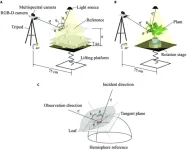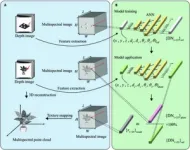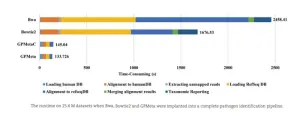(Press-News.org) Modern cameras and sensors, together with image processing algorithms and artificial intelligence (AI), are ushering in a new era of precision agriculture and plant breeding. In the near future, farmers and scientists will be able to quantify various plant traits by simply pointing special imaging devices at plants. However, some obstacles must be overcome before these visions become a reality. A major issue faced during image-sensing is the difficulty of combining data from the same plant gathered from multiple image sensors, also known as ‘multispectral’ or ‘multimodal’ imaging. Different sensors are optimized for different frequency ranges and provide useful information about the plant. Unfortunately, the process of combining plant images acquired using multiple sensors, called ‘registration,’ can be notoriously complex.
Registration is even more complex when involving three-dimensional (3D) multispectral images of plants at close range. To properly align close-up images taken from different cameras, it is necessary to develop computational algorithms that can effectively address geometric distortions. Besides, algorithms that perform registration for close-range images are more susceptible to errors caused by uneven illumination. This situation is commonly faced in the presence of leaf shadows, as well as light reflection and scattering in dense canopies.
Against this backdrop, a research team including Professor Haiyan Cen from Zhejiang University, China, recently proposed a new approach for generating high-quality point clouds of plants by fusing depth images and snapshot spectral images. As explained in their paper, which was published in Volume 5 of Plant Phenomics on 3 April 2023, the researchers employed a three-step image registration process which was combined with a novel artificial intelligence (AI)-based technique to correct for illumination effects. Prof. Cen explains, “Our study shows that it is promising to use stereo references to correct plant spectra and generate high-precision, 3D, multispectral point clouds of plants.”
The experimental setup consisted of a lifting platform which held a rotating stage at a preset distance from two cameras on a tripod; an RGB (red, green, and blue)-depth camera and a snapshot multispectral camera. In each experiment, the researchers placed a plant on the stage, rotated the plant, and photographed it from 15 different angles. They also took images of a flat surface containing Teflon hemispheres at various positions. The images of these hemispheres served as reference data for a reflectance correction method, which the team implemented using an artificial neural network.
For registration, the team first used image processing to extract the plant structure from the overall images, remove noise, and balance brightness. Then, they performed coarse registration using Speeded-Up Robust Features (SURF)—a method that can identify important image features that are mostly unaffected by changes in scale, illumination, and rotation. Finally, the researchers performed fine registration using a method known as ‘Demons.’ This approach is based on finding mathematical operators that can optimally ‘deform’ one image to match it with another.
These experiments showed that the proposed registration method significantly outperformed conventional approaches. Moreover, the proposed reflectance correction technique produced remarkable results, as Prof. Cen highlights: “We recommended using our correction method for plants in growth stages with low canopy structural complexity and flattened and broad leaves.” The study also highlighted a few potential areas of improvement to make the proposed approach even more powerful.
Satisfied with the results, Prof. Cen concludes: “Overall, our method can be used to obtain accurate, 3D, multispectral point cloud model of plants in a controlled environment. The models can be generated successively without varying the illumination condition.” In the future, techniques such as this one will help scientists, farmers, and plant breeders easily integrate data from different cameras into one consistent format. This could not only help them visualize important plant traits, but also feed these data to emerging AI-based software to simplify or even fully automate analyses.
We surely are excited to see the impact of 3D multispectral imaging of plants in precision agriculture and phenotyping!
###
Reference
Authors
Pengyao Xie1,2, Ruiming Du1,2, Zhihong Ma1,2, and Haiyan Cen1,2
Affiliations
1College of Biosystems Engineering and Food Science, Zhejiang University
2Key Laboratory of Spectroscopy Sensing, Ministry of Agriculture and Rural Affairs
END
Novel ‘registration’ method identifies plant traits in close-up photos
Researchers introduce a new approach to correct illumination effects in close-up plant images
2023-04-26
ELSE PRESS RELEASES FROM THIS DATE:
Introducing GPMeta: Ultrarapid GPU-accelerated pathogen identification approach
2023-04-26
Metagenomic sequencing (mNGS) is a powerful diagnostic tool to detect causative pathogens in clinical microbiological testing. Rapid and accurate classification of metagenomic sequences is a critical procedure for pathogen identification in the dry-lab step of mNGS tests. However, this crucial step may be improved by classifying sequences within a clinically relevant timeframe.
To address this challenge, a BGI Genomics team led by Xuebin Wang has recently launched GPMeta, an ultra-fast pathogen detection approach, and published these highlights ...
Alarming rates of teen suicide continue to increase in the US
2023-04-26
In the United States suicide has become the second leading cause of premature death among those ages 10 to 24; it is the leading cause of death among teens ages 13 to 14.
Researchers from Florida Atlantic University’s Schmidt College of Medicine and collaborators conducted a study exploring trends in rates of suicide among 13 to 14 year olds in the U.S. from 1999 to 2018. They also explored possible modifications by sex, race, level of urbanization, census region, month of the year and day of the week.
Results, published online ahead of print in the journal Annals of Pediatrics and Child Health, showed that among children ages 13 to 14, suicide rates ...
Thinking About an Unconventional Spelling for Your New Product or Service? You May Want to Reconsider
2023-04-26
Researchers from University of Notre Dame and The Ohio State University published a new Journal of Marketing study that examines how the use of unconventional spellings of a brand name impacts consumers’ inferences about and willingness to support the brand.
The study, forthcoming in the Journal of Marketing, is titled “‘Choozing’ the Best Spelling: Consumer Response to Unconventionally Spelled Brand Names” and is authored by John P. Costello, Jesse Walker, and Rebecca Walker Reczek.
Choosing a brand ...
Degrading viral RNA to treat SARS-CoV-2 infection
2023-04-26
Development of vaccines against SARS-CoV-2 has been rapid, but the rise of variants forces scientists to frequently modify treatments. Ideally, therapies would target mutation-resistant viral proteins, but this has proven difficult. Researchers reporting in ACS Central Science, however, have now developed a system that directly targets and degrades the viral RNA genome, reducing infection in mice. The method could be adapted to fight off many viruses, as well as treat various diseases.
Vaccines and antiviral drugs typically target proteins critical to viral infection and replication. This ...
U.S. adults who felt discrimination at work faced increased risk of high blood pressure
2023-04-26
Research Highlights:
U.S. adults who reported feeling highly discriminated against at work had an increased risk of developing high blood pressure than those who reported low discrimination at work.
Researchers suggest government and employer anti-discrimination policies and interventions may help to eliminate discrimination in the workplace.
Embargoed until 4 a.m. CT/5 a.m. ET Wednesday, April 26, 2023
DALLAS, April 26, 2023 — U.S. adults who reported feeling discriminated against at work had a higher risk for developing high ...
Innovative treatment targets blood clots without increased bleeding risk
2023-04-26
Safer and more effective blood thinners could be on the way following a groundbreaking discovery by researchers at UBC and the University of Michigan, published today in Nature Communications.
By combining their expertise in blood clotting systems and chemical synthesis, the researchers have designed a new compound called MPI 8 that offers the potential to prevent blood clots without any increased risk of bleeding—a common side effect of existing blood thinners.
“The development of MPI 8 represents a major breakthrough in the field of blood clot prevention and treatment,” said Dr. Jay Kizhakkedathu, a professor and Canada Research ...
Researchers show genetic basis of facial changes in Down Syndrome
2023-04-26
Researchers at the Francis Crick Institute, King’s College London and University College London have shed light on the genetics behind changes in the structure and shape of the face and head in a mouse model of Down Syndrome.
Described in a paper published today in Development, the researchers found that having a third copy of the gene Dyrk1a and at least three other genes were responsible for these changes taking place in development – called craniofacial dysmorphology – which involve shortened back-to-front length and widened diameter of the head.
Affecting ...
Gestational weight gain z scores, standardized by pre-pregnancy BMI, associated with susceptibility to autism-related traits
2023-04-26
ROCKVILLE, Md.—Gestational weight gain may be associated with autism-related behaviors among children who have a greater pre-disposition to these behaviors and who have mothers with pre-pregnancy overweight or obesity, according to a new study in Obesity, The Obesity Society’s (TOS) flagship journal.
Excessive gestational weight gain has been associated with neurodevelopmental outcomes in children, including autism spectrum disorder and related traits. However, it is unclear how pre-pregnancy body mass index (BMI) or familial susceptibility to autism spectrum disorder influences the gestational weight gain-autism traits association, ...
Longer siestas linked to higher risk of obesity, metabolic syndrome, and high blood pressure
2023-04-26
It is a common custom in some countries for individuals to take a siesta or midday nap. Sleeping during the middle of the day has the potential to affect sleep quality, cognitive function, and metabolic processes. However, the relationship between siestas and metabolic health is not well understood. A new study led by investigators from Brigham and Women’s Hospital, a founding member of the Mass General Brigham healthcare system, assessed more than 3,000 adults from a Mediterranean population, examining the relationship of siestas and siesta duration with obesity and metabolic syndrome. The researchers found that those who took siestas of 30 minutes or longer (long siestas) were more ...
The hidden power of Japanese food ― inhibiting the development of liver fibrosis
2023-04-26
Japanese food is popular worldwide and has been registered as a UNESCO Intangible Cultural Heritage. There is a scoring system named “the 12-component modified Japanese Diet Index (mJDI12),” which focuses on the intake of the Japanese diet pattern. It includes 12 foods and food groups: rice, miso soup, pickles, soy products, green and yellow vegetables, fruits, seafood, mushrooms, seaweed, green tea, coffee, and beef and pork. Scores range from 0 to 12, with higher scores indicating a diet that conforms to the Japanese food pattern.
A research group led by Dr. Hideki Fujii ...
LAST 30 PRESS RELEASES:
Injectable breast ‘implant’ offers alternative to traditional surgeries
Neuroscientists devise formulas to measure multilingualism
New prostate cancer trial seeks to reduce toxicity without sacrificing efficacy
Geometry shapes life
A CRISPR screen reveals many previously unrecognized genes required for brain development and a new neurodevelopmental disorder
Hot flush treatment has anti-breast cancer activity, study finds
Securing AI systems against growing cybersecurity threats
Longest observation of an active solar region
Why nail-biting, procrastination and other self-sabotaging behaviors are rooted in survival instincts
Regional variations in mechanical properties of porcine leptomeninges
Artificial empathy in therapy and healthcare: advancements in interpersonal interaction technologies
Why some brains switch gears more efficiently than others
UVA’s Jundong Li wins ICDM’S 2025 Tao Li Award for data mining, machine learning
UVA’s low-power, high-performance computer power player Mircea Stan earns National Academy of Inventors fellowship
Not playing by the rules: USU researcher explores filamentous algae dynamics in rivers
Do our body clocks influence our risk of dementia?
Anthropologists offer new evidence of bipedalism in long-debated fossil discovery
Safer receipt paper from wood
Dosage-sensitive genes suggest no whole-genome duplications in ancestral angiosperm
First ancient human herpesvirus genomes document their deep history with humans
Why Some Bacteria Survive Antibiotics and How to Stop Them - New study reveals that bacteria can survive antibiotic treatment through two fundamentally different “shutdown modes”
UCLA study links scar healing to dangerous placenta condition
CHANGE-seq-BE finds off-target changes in the genome from base editors
The Journal of Nuclear Medicine Ahead-of-Print Tip Sheet: January 2, 2026
Delayed or absent first dose of measles, mumps, and rubella vaccination
Trends in US preterm birth rates by household income and race and ethnicity
Study identifies potential biomarker linked to progression and brain inflammation in multiple sclerosis
Many mothers in Norway do not show up for postnatal check-ups
Researchers want to find out why quick clay is so unstable
Superradiant spins show teamwork at the quantum scale
[Press-News.org] Novel ‘registration’ method identifies plant traits in close-up photosResearchers introduce a new approach to correct illumination effects in close-up plant images




